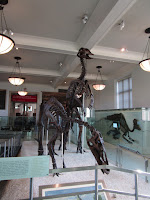 So I've been posting on Seeking Behemoth for a while now, and have yet to explain where the name comes from. I suppose its about time for that.
So I've been posting on Seeking Behemoth for a while now, and have yet to explain where the name comes from. I suppose its about time for that.Many people hear the word behemoth, but not everyone knows where it comes from. In the Christian Bible, in a description of his creation and power, God talks about something called 'behemoth.' The description goes like this:
 “Look at Behemoth, which I made along with you and which feeds on grass like an ox. What strength it has in its loins, what power in the muscles of its belly! Its tail sways like a cedar; the sinews of its thighs are close-knit. Its bones are tubes of bronze, its limbs like rods of iron. It ranks first among the works of God, yet its Maker can approach it with his sword. The hills bring it their produce, and all the wild animals play nearby. Under the lotus plants it lies, hidden among the reeds in the marsh. The lotuses conceal it in their shadow; the poplars by the stream surround it. A raging river does not alarm it; it is secure, though the Jordan should surge against its mouth. Can anyone capture it by the eyes, or trap it and pierce its nose?"
“Look at Behemoth, which I made along with you and which feeds on grass like an ox. What strength it has in its loins, what power in the muscles of its belly! Its tail sways like a cedar; the sinews of its thighs are close-knit. Its bones are tubes of bronze, its limbs like rods of iron. It ranks first among the works of God, yet its Maker can approach it with his sword. The hills bring it their produce, and all the wild animals play nearby. Under the lotus plants it lies, hidden among the reeds in the marsh. The lotuses conceal it in their shadow; the poplars by the stream surround it. A raging river does not alarm it; it is secure, though the Jordan should surge against its mouth. Can anyone capture it by the eyes, or trap it and pierce its nose?"It isn't a word that's been translated except to make it pronounceable in English, and today the original word is only known to mean some kind of animal. In some contexts, the word gets translated into "cow."
 In English, the word has come to mean some large, powerful beast that people have no control over. Likely it has something to do with this passage. Scholars have suggested that the description refers to a hippo, an elephant, or a buffalo, or something of that nature. Some have suggested it may even be a description of a dinosaur, like one of the sauropods. We know now that sauropods likely weren't swimmers; the water pressure would've crushed them. The point is, though, that we don't know what it looked like.
In English, the word has come to mean some large, powerful beast that people have no control over. Likely it has something to do with this passage. Scholars have suggested that the description refers to a hippo, an elephant, or a buffalo, or something of that nature. Some have suggested it may even be a description of a dinosaur, like one of the sauropods. We know now that sauropods likely weren't swimmers; the water pressure would've crushed them. The point is, though, that we don't know what it looked like. It's this way with a lot of prehistoric animals. We have a piece of bone, or maybe a skeleton, but any attempt we have to flesh them out is only guessing. We don't know what they looked like, but we're always keeping it in mind, trying to piece together the few hints that we do have to 'seek out' what the actual animal looked like. We don't know their posture, we don't know how much flesh would've been on their bones, we don't know what they ate or how they acted.
It's this way with a lot of prehistoric animals. We have a piece of bone, or maybe a skeleton, but any attempt we have to flesh them out is only guessing. We don't know what they looked like, but we're always keeping it in mind, trying to piece together the few hints that we do have to 'seek out' what the actual animal looked like. We don't know their posture, we don't know how much flesh would've been on their bones, we don't know what they ate or how they acted.So that's where the name comes from; digging for mysterious beasts that we always want to know more about but may never have an exact, full picture of. One that inspires curiosity but can only begin to be guessed at.
Besides. It has a nice ring to it, don't ya think?
No comments:
Post a Comment